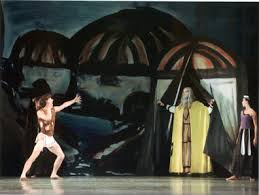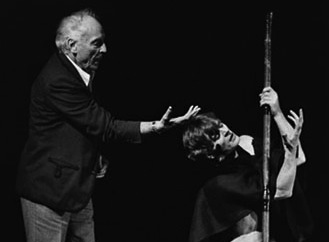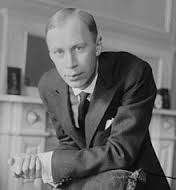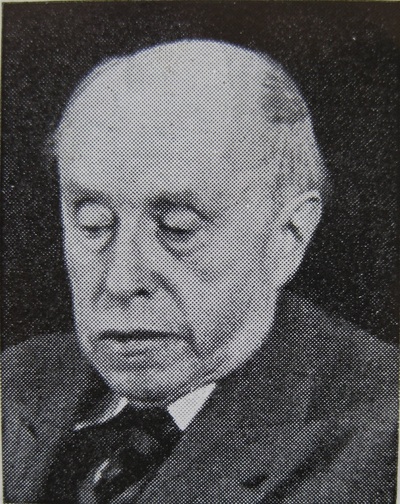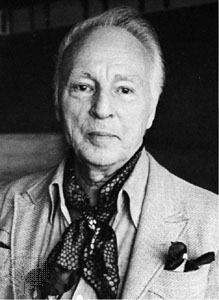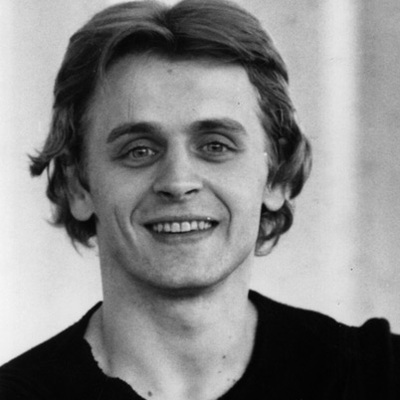The Prodigal Son
George Balanchine, Choreographer
A Study Guide by Lee Magness
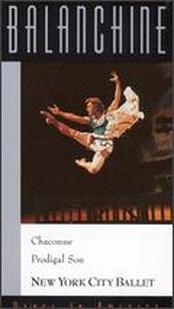
Background
It is amazing enough when any one of an era’s great artists tackles the grandest of Jesus’ parables, the Prodigal Son. But it is especially striking when a cluster of great artists combine their virtuosities in a presentation of the parable. That is exactly what happened in 1929. One of the 20th century’s greatest choreographers, George Balanchine, choreographed a ballet based on the parable (portrait, lower center above; with Baryshnikov, upper center). Balanchine built on the foundation of music by one of the 20th century’s greatest composers, Sergei Prokofiev (upper right). Sets and costumes were designed by one of the 20th century’s greatest expressionist painter, Georges Rouault (portrait, lower left; scene with set and costumes, upper left). The scenes of the ballet were imagined not directly from the parable itself but from paintings of the parable as described by the great Russian writer Alexander Pushkin in his short story, “The Station-master” (“The Postmaster”).
The ballet was first performed in May 1929 by the Ballets Russes in Paris’ Théâtre Sarah Bernhardt. Balanchine directed the dancing; Prokofiev himself conducted the orchestra a mere three months before his death. Since then the ballet has been performed by many great ballet companies and some of the world’s greatest dancers have recreated the role of the Prodigal. This 1979 production, using the choreography of Balanchine, the music of Prokofiev, and the actual backdrops of Rouault, features the New York City Ballet and its principle dancer Mikhail Baryshnikov (portrait, lower right; with Balanchine, upper center).
You may watch the ballet at 4 separate youtube sites:
Part 1 ~ by clicking here Part 2 ~ by clicking here
Part 3 ~ by clicking here Part 4 ~ by clicking here
Viewing/Study Guide
As you watch, prepare to respond to the following questions:
1) What is your take on the portrayal of the Prodigal?
2) What is your take on the portrayal of the Father?
3) Why do you think the Sisters were added? Do you find their presence a help or a hindrance?
4) What is the impact of the ballet being set predominately in the far country?
5) What roles do the ensemble dancers play?
6) What do you make of the dominating presence of the Siren?
7) What symbolism do you notice in the production?
8) Do you find the reunion scene meaningful? Why or why not?
9) What is your assessment of the ballet as a vehicle for the message of the parable?
It is amazing enough when any one of an era’s great artists tackles the grandest of Jesus’ parables, the Prodigal Son. But it is especially striking when a cluster of great artists combine their virtuosities in a presentation of the parable. That is exactly what happened in 1929. One of the 20th century’s greatest choreographers, George Balanchine, choreographed a ballet based on the parable (portrait, lower center above; with Baryshnikov, upper center). Balanchine built on the foundation of music by one of the 20th century’s greatest composers, Sergei Prokofiev (upper right). Sets and costumes were designed by one of the 20th century’s greatest expressionist painter, Georges Rouault (portrait, lower left; scene with set and costumes, upper left). The scenes of the ballet were imagined not directly from the parable itself but from paintings of the parable as described by the great Russian writer Alexander Pushkin in his short story, “The Station-master” (“The Postmaster”).
The ballet was first performed in May 1929 by the Ballets Russes in Paris’ Théâtre Sarah Bernhardt. Balanchine directed the dancing; Prokofiev himself conducted the orchestra a mere three months before his death. Since then the ballet has been performed by many great ballet companies and some of the world’s greatest dancers have recreated the role of the Prodigal. This 1979 production, using the choreography of Balanchine, the music of Prokofiev, and the actual backdrops of Rouault, features the New York City Ballet and its principle dancer Mikhail Baryshnikov (portrait, lower right; with Balanchine, upper center).
You may watch the ballet at 4 separate youtube sites:
Part 1 ~ by clicking here Part 2 ~ by clicking here
Part 3 ~ by clicking here Part 4 ~ by clicking here
Viewing/Study Guide
As you watch, prepare to respond to the following questions:
1) What is your take on the portrayal of the Prodigal?
2) What is your take on the portrayal of the Father?
3) Why do you think the Sisters were added? Do you find their presence a help or a hindrance?
4) What is the impact of the ballet being set predominately in the far country?
5) What roles do the ensemble dancers play?
6) What do you make of the dominating presence of the Siren?
7) What symbolism do you notice in the production?
8) Do you find the reunion scene meaningful? Why or why not?
9) What is your assessment of the ballet as a vehicle for the message of the parable?
